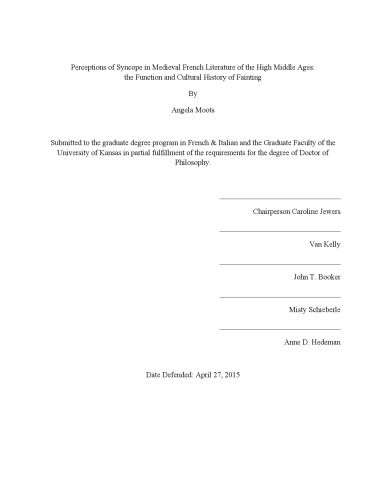Product desciption
Perceptions Of Syncope In Medieval French Literature Of The High Middle Ages The Function And Cultural History Of Fainting Angela Moots by Angela Moots instant download after payment.
This dissertation analyzes the diverse instances of syncope in Old French Literature from the first appearance of the verb to faint, “pasmer,” in the eleventh-century hagiographical text La Vie de saint Alexis, to the epics, the romances based on classical antiquity, the works of Chrétien de Troyes, and the thirteenth-century romances of the Arthurian Lancelot en prose. In literature, syncope ranges from a simple collapse or swooning to an extended period of unconsciousness or trance-like paralysis, and results from factors such as distress, injury, illness, love, joy, fear, or indecision. In addition to being physical, psychological, or emotional, fainting can be gendered in unexpected ways, as the male characters lose consciousness most frequently. In this study, I show that syncope highlights certain events and characteristics, externalizes emotions, dramatizes illnesses, unveils hidden love, shows the effects of broken relationships, and depicts the consequences of actions. Moreover, it can have a deeper signification, symbolizing an outer manifestation of sin or a loss of power. Interestingly, the increasing role of syncope in literature coincides with the increasing popularity of medical learning, treatments, and herbals during the High Middle Ages.
The first chapter shows that hagiography uses fainting to emphasize overwhelming emotions after the loss of a loved one, while the masculine world of epic poetry illustrates that a loss of consciousness can be ideological, showing the knights’ unwavering devotion despite suffering. Transitioning to the romans d’antiquité of chapter two, the paradigm of syncope extends, and the poets emphasize love’s emotional toll with fainting as a symptom of lovesickness in both men and women. In the third chapter, fainting and trances are visible in the protagonists of Chrétien de Troyes’s romances, as characters struggle to restore relationships, escape to be with a lover, hide emotions, obey a courtly lady, and understand God’s love. In the concluding chapter, syncope aids in characterization in the Lancelot en prose, and the greater psychological focus on the characters is evident in instances of trance-like unconsciousness. Syncope is much more than a dramatic spectacle, and authors use the motif to redirect attention to important characters, themes, or events.


